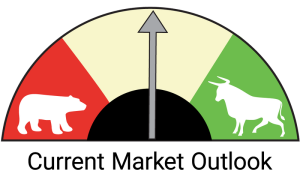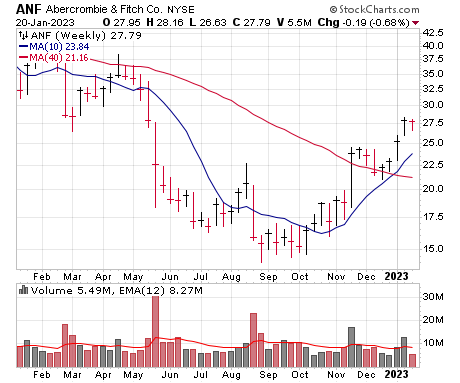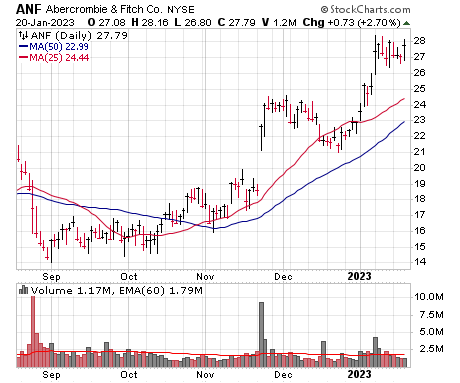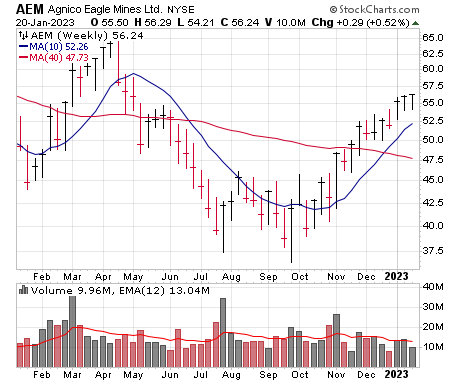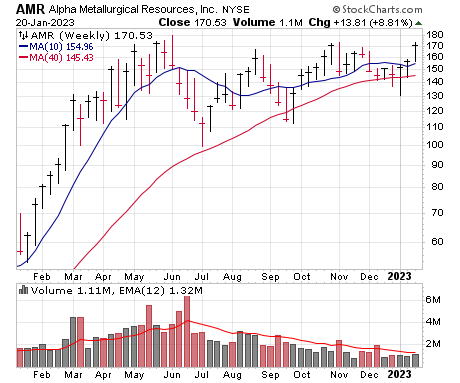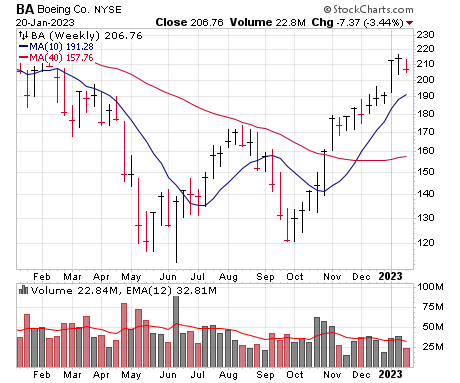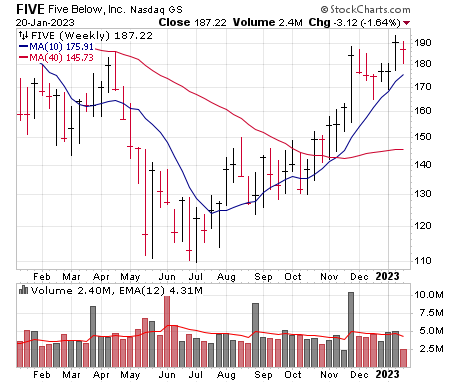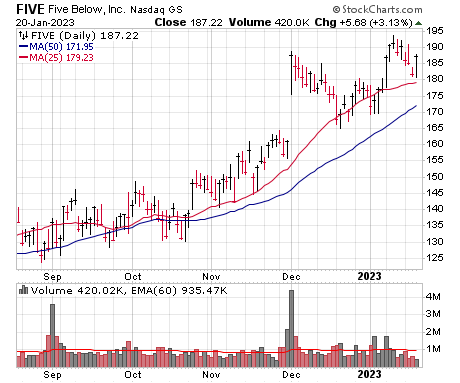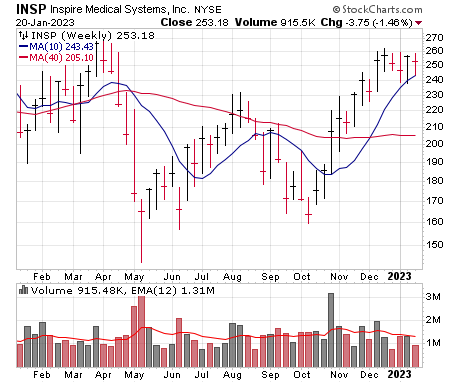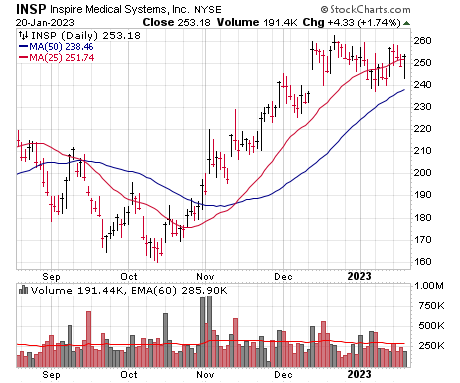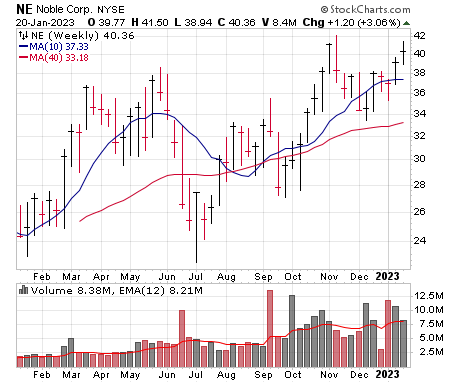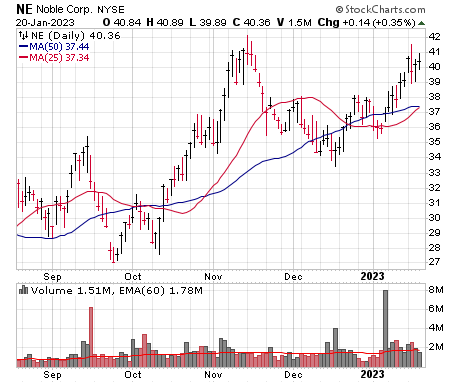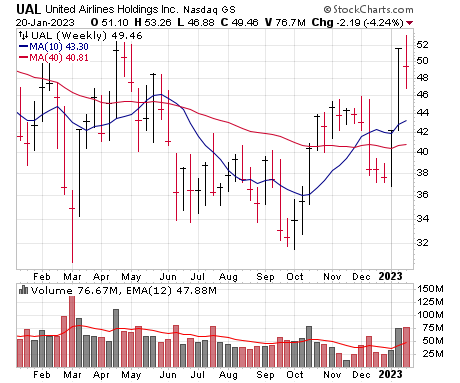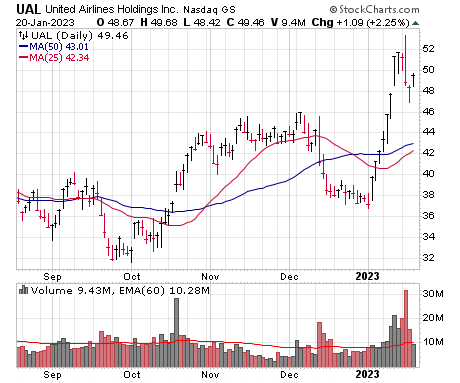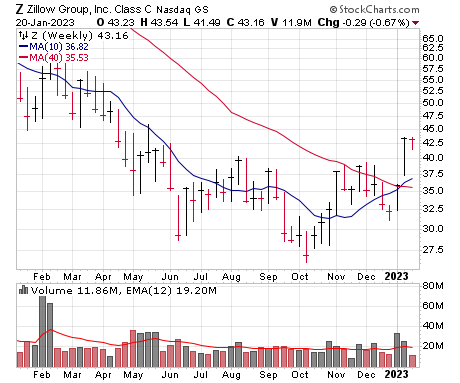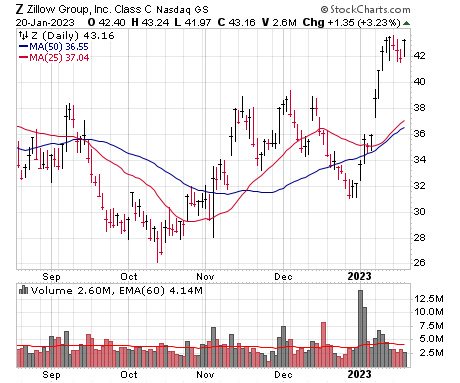Decent Start
It was a down-and-up week for the market, with a round of selling hitting the major indexes and many stocks as they approached their December highs, which is par for the course in this environment—but then a solid-looking snapback on Friday and today. Moreover, most of the nascent positives that we’ve written about are still in place, with the broad market in solid shape (the number of new lows remains tame) and the 2-to-1 Blastoff Indicator still in effect; now we want to see the intermediate-term trend (currently still neutral as most indexes are rangebound during the past two months) kick into gear and some breakouts occur; so far, we’re still seeing a lot of buying in off-the-bottom stuff and growth stocks being rejected near resistance. Even so, we’re encouraged, though we still think going slow (especially with earnings season upon us) makes sense. We’ll leave our Market Monitor at a level 5, though a rush of buying from here could change that.
This week’s list is again heavy on the cyclical- and turnaround-type names, as that’s where most of the strength has been. Our Top Pick is Alpha Metallurgical (AMR), which is perking up along with most of its coal peers. It’s right near resistance, so we suggest starting small and aiming for pullbacks.
| Abercrombie & Fitch (ANF) |
| Agnico Eagle (AEM) |
| Alpha Metallurgical (AMR) ★ Top Pick ★ |
| Boeing (BA) |
| Five Below (FIVE) |
| Inspire Medical (INSP) |
| Noble Corp. (NE) |
| Toll Brothers (TOL) |
| United Airlines (UAL) |
| Zillow (Z) |
Stock 1
Abercrombie & Fitch (ANF)
Price | Buy Range | Loss Limit |
Why the Strength
U.S. retailers are reporting disappointing holiday sales, making Ohio-based Abercrombie & Fitch’s recent update that fourth-quarter sales will come in better than expected welcome news. Management says Q4 revenue will likely end 1% to 2% higher than 2021 with an improving operating margin too, a nice swing from their earlier projection that the period’s sales could decline as much as 4% with slightly weaker margins. It’s the second-straight quarter the company has beaten consensus expectations, suggesting the gains are more than luck, as women’s apparel had its best growth for the firm in 15 years going into the final quarter. Abercrombie also probably benefits from the fact they’re don’t market to older, wealthier consumers, who are the ones restraining their spending the most. The company’s 750-plus stores and its five brands—Hollister, Gilly Hicks, Social Tourist and the eponymous A&F as well as Abercrombie Kids—target millennials and younger consumers. In particular, the company has scored with newer brands Gilly Hicks and Social Tourist; the former is positioned as a lifestyle brand for active Gen Zers while Social Tourist aims for the social media conscious and influencer-inspired shoppers. The brands are helped by A&F’s strong emphasis on digital sales, which account for more than half of revenue. 2022 sales will hit about $3.7 billion, which gets the business back to pre-pandemic levels, management is targeting sales of around $4.2 billion by 2025 through a combination of opening smaller stores that are in better locations and continuing to pound marketing through social media and other digital efforts. The big idea here is that the dry times of last year should give way to a solid business/earnings rebound in 2023. The next report is likely out in early March.
Technical Analysis
ANF imploded as low as 14 last summer, down more than two-thirds from its 2021 peak in the upper 40s. The first couple of months of the recovery were so-so at best, but a gap up on Q3 earnings in November changed the landscape—ANF proceeded to hold its 40-week line in December and extend higher so far this year on another round of good-volume buying. We suggest targeting dips of a couple of points if you want in.
| Market Cap | $1.38B | EPS $ Annual (Jan) | ||
| Forward P/E | N/A | FY 2021 | -0.73 | |
| Current P/E | N/A | FY 2022 | 4.35 | |
| Annual Revenue | $3.66B | FY 2023e | 0.25 | |
| Profit Margin | 0.1% | FY 2024e | 1.74 | |
| Qtrly Rev | Qtrly Rev Growth | Qtrly EPS | Qtrly EPS Growth | |
| ($M) | (vs. yr-ago-qtr) | ($) | (vs. yr-ago-qtr) | |
| Latest qtr | 880 | -3% | 0.01 | -99% |
| One qtr ago | 805 | -7% | -0.30 | N/A |
| Two qtrs ago | 813 | 4% | -0.27 | N/A |
| Three qtrs ago | 1161 | 4% | 1.14 | -24% |
Weekly Chart | Daily Chart |
Stock 2
Agnico Eagle (AEM)
Price | Buy Range | Loss Limit |
Why the Strength
A weaker U.S. dollar and lower Treasury yields have boosted gold’s appeal entering 2023. The price strength has been a boon for Agnico (covered in the December 5 issue), a senior Canadian producer with a pipeline of high-quality exploration and development projects in the U.S., Canada, Mexico and Columbia. Agnico is poised to significantly increase its gold production in 2023 beyond, boasting all-in sustaining costs (a key metric) of under $1,100 per ounce in Q3, which is well under the current gold price of $1,930. This in turn translates to some very attractive margins for the company despite rising operating costs, which is obviously one of the key attractions for Agnico. Another reason for optimism is Agnico’s recent merger with Kirkland Lake Gold, which provided Agnico with access to the Detour Lake mine in Canada—its largest reserve base at a whopping 15 million ounces. Detour Lake is expected to be the company’s largest gold producer, boasting an estimated mine life of up to 40 years, and it’s projected to provide Agnico with around 800,000 ounces of gold per year for the next 20 years! (Agnico also jointly owns the world’s ninth-ranked gold mine, the Canadian Malartic, with Yamana Gold). Further out, Agnico has at least five major gold assets among its advanced pipeline projects extending out to 2030, which have the potential to boost its annual gold production to between four and five million ounces, up from around two million ounces currently. If and when those come online, they would make the company a top-three gold producer globally (the firm was the sixth largest in terms of output as of 2021). Wall Street is relatively reserved, seeing earnings basically flat in 2023, but the longer gold prices remain elevated, the better the odds those figures prove low. A 2.8% dividend yield helps the cause as well. Earnings are due February 16.
Technical Analysis
After a good start to 2022, AEM spent most of last year in the doldrums, dropping almost 30 points from a mid-April peak to a late-September nadir at around 37. A few weeks of bottoming followed, and shares turned a corner on strong volume in November. The stock has advanced steadily since then, with AEM persistently marching higher above its 25-day line for the past 10 weeks or so—including some tight trading this month. We’ll set our buy range down a bit, thinking another visit to the 25-day line is likely.
| Market Cap | $25.6B | EPS $ Annual (Dec) | ||
| Forward P/E | 27 | FY 2020 | 1.86 | |
| Current P/E | 24 | FY 2021 | 2.48 | |
| Annual Revenue | $5.31B | FY 2022e | 2.25 | |
| Profit Margin | 16.2% | FY 2023e | 2.05 | |
| Qtrly Rev | Qtrly Rev Growth | Qtrly EPS | Qtrly EPS Growth | |
| ($B) | (vs. yr-ago-qtr) | ($) | (vs. yr-ago-qtr) | |
| Latest qtr | 1.45 | 47% | 0.52 | -15% |
| One qtr ago | 1.58 | 61% | 0.75 | 6% |
| Two qtrs ago | 1.33 | 40% | 0.61 | -14% |
| Three qtrs ago | 0.95 | 2% | 0.46 | -31% |
Weekly Chart | Daily Chart |
Stock 3
Alpha Metallurgical (AMR) ★ Top Pick ★
Price | Buy Range | Loss Limit |
Why the Strength
China is taking major steps to increase its steel output after easing Covid restrictions, including initiatives to boost domestic construction spending. Meanwhile, higher infrastructure spending—along with the reshoring of semiconductor fabrication to the U.S., boosting construction activity here—is also expected to accelerate steel consumption this year. Together, these trends are expected to lift the demand for metallurgical, or “met,” coal used in steel production. Alpha Metallurgical is America’s largest producer and exporter of met coal, with over 20 underground and surface mining operations across Virginia and West Virginia. Pricing exploded last year and should come down some, but the above demand factors should keep things buoyant—Alpha announced operations guidance for 2023 that included a 7% increase in shipments from 2022 levels, with around 16 million tons of met coal expected to account for nearly all of its projected total shipments of around 17 million tons. Alpha further said it expects global supplies to remain tight “for some time to come” and that it’s “well positioned” to ship more coal this year, adding that around 62% of its metallurgical tons are already contracted for the coming year, with roughly half of them priced around $193 per ton (14% above the three-year coal price average). On the financial front, the company posted revenue of $870 million in Q3 (up 34% from a year ago), with per-share earnings of $14.21 missing estimates but more than tripling from the year before. But the company’s generous shareholder returns is what caught Wall Street’s attention: Alpha sports a modest 1%-ish dividend, but also paid a special one-time $5 dividend in Q3 and has been buying back shares like mad, reducing the share count by nearly 14% in the 12 months through October. Analysts see earnings remaining through the roof this year, which should lead to more big shareholder returns.
Technical Analysis
AMR had a gigantic advance that ended near 180 last June and led to a quick 44% drop that found support near the 40-week line. Since then, the stock hasn’t set the world on fire, but it’s had two higher lows (September and then January), with a tidy three-month structure forming—and now AMR is ramping again as volume picks up a bit, while some coal peers also perk up. Shares are very volatile and back up into resistance, so if you’re game, start small and aim for dips.
| Market Cap | $2.72B | EPS $ Annual (Dec) | ||
| Forward P/E | 4 | FY 2020 | -13.20 | |
| Current P/E | 2 | FY 2021 | 15.20 | |
| Annual Revenue | $4.11B | FY 2022e | 83.28 | |
| Profit Margin | 29.0% | FY 2023e | 39.77 | |
| Qtrly Rev | Qtrly Rev Growth | Qtrly EPS | Qtrly EPS Growth | |
| ($M) | (vs. yr-ago-qtr) | ($) | (vs. yr-ago-qtr) | |
| Latest qtr | 870 | 34% | 14.21 | 221% |
| One qtr ago | 1336 | 238% | 30.03 | N/A |
| Two qtrs ago | 1072 | 178% | 20.52 | N/A |
| Three qtrs ago | 828 | 156% | 13.37 | N/A |
Weekly Chart | Daily Chart |
Stock 4
Boeing (BA)
Price | Buy Range | Loss Limit |
Why the Strength
Some of the biggest obstacles that hindered growth among the world’s largest aerospace contractors—namely supply chain backups and labor problems—are expected to ease this year. That should provide a major catalyst for Boeing (covered in the January 3 issue), which has a multi-year backlog for its many offerings, most notably the 737 MAX and 787 Dreamliner jets. The latest sign that Boeing is back on track to increase production was its December delivery report, which revealed that the firm completed 69 commercial airplanes to finish the year with a total of 480 deliveries—a 40% improvement from the prior year and, even better, the report detailed accelerating growth as the year went on (Q4 deliveries were up 60%). The improvement in deliveries was a reason for the stock’s latest strength, helping to back up the company’s initiative to achieve $10 billion in free cash flow by 2025-2026. Boeing’s cash flow objective hinges in part on its ability to produce an average 50 of the 737 jets per month by 2025, which it’s already achieved by cranking out 53 of them in December, in addition to delivering 10 of the 787s. Several Wall Street institutions were sufficiently impressed by Boeing’s progress to upgrade the stock, with one major bank adding the stock to its list of high-conviction, long-term ideas based on the company’s “robust” cash generation, an under-supplied aviation market and improving production rates. On the financial front, Boeing’s Q3 revenue of $16 billion was only modestly higher (up 4%), but when the firm reports Q4 results on Wednesday (January 25), analysts expect the top line to jump 35% from a year ago—and improve 25% from the prior quarter—while earnings are seen leaping to $3.50 per share for 2023 as the firm finally puts the pandemic struggles in its rear-view mirror.
Technical Analysis
We missed getting into BA earlier this month after the stock refused to pull into our buy range, but we think an opportunity could be forthcoming—shares have been very strong since early October, but near term, BA got a smidge out of trend on the upside, which generally leads to a little shakeout. The pullback thus far is very tame (and has come on very low volume). We’ll set our range a bit lower, thinking any pre- or post-earnings dip could be buyable; we’ll set a loss limit just under the 50-day line.
| Market Cap | $122B | EPS $ Annual (Dec) | ||
| Forward P/E | 59 | FY 2020 | -23.24 | |
| Current P/E | N/A | FY 2021 | -9.43 | |
| Annual Revenue | $61.5B | FY 2022e | -8.34 | |
| Profit Margin | N/A | FY 2023e | 3.49 | |
| Qtrly Rev | Qtrly Rev Growth | Qtrly EPS | Qtrly EPS Growth | |
| ($B) | (vs. yr-ago-qtr) | ($) | (vs. yr-ago-qtr) | |
| Latest qtr | 16.0 | 4% | -6.18 | 75% |
| One qtr ago | 16.7 | -2% | -0.37 | 67% |
| Two qtrs ago | 14.0 | -8% | -2.75 | 62% |
| Three qtrs ago | 14.8 | -3% | -7.69 | 86% |
Weekly Chart | Daily Chart |
Stock 5
Five Below (FIVE)
Price | Buy Range | Loss Limit |
Why the Strength
At its core, Five Below has always had what might be the best growth story in retail: The firm’s unique concept of being a new type of dollar store that sells all types of goods (mostly for teens and pre-teens, but that’s broadening out to young adults) generally for $5 or less (though it’s moving that up to $10 on more and more items) has been a hit, and its stores (9,000 square feet on average) have had the best economics we’ve ever come across, with a payback of the initial cost in less than a year, which when combined with the huge potential (management thinks Five Below can have more than 3,500 stores in the U.S. alone, compared to nearly 1,300 at the end of October), has allowed for a rapid store expansion plan (usually 10%-plus every year) that shows no sign of slowing down. All that said, the company has faced more than a few headwinds in recent years, first with the U.S.-China trade war (tariffs threatened to hurt margins), then the pandemic (store closures), then inflation (again hurting margins), all while investing in more distribution centers and technology to support the store expansion. But now, maybe, it looks like the potholes are in the past and the underlying 20%-plus earnings growth story is back on track. Indeed, the firm’s Q4 pre-announcement earlier this month was terrific, with comparable store sales up 0.9% during the holidays (snapping a shrinkage streak), total sales up more than 11%, earnings expected to rise 20% or more and with 200-plus stores likely opening in 2023. Looking out, the top brass believes $10 in earnings (up from $4.69 last year) is possible by 2025 (could be an aggressive target, but still) and north of 3,500 stores by 2030. There’s a lot to like here. Earnings will be out in early March.
Technical Analysis
FIVE bottomed back in July and began to slowly move higher from there, with the market’s autumn retreat barely denting the stock (obviously a good sign). Shares finally flexed their muscle after earnings in early December, with FIVE gapping up nicely—the stock’s ensuing dip was normal, and the good-volume move to new highs earlier this month (after Q4 guidance) was encouraging, too, knocking on the door of new 52-week highs. We’re OK taking a swing at the stock on dips if you don’t own any.
| Market Cap | $10.4B | EPS $ Annual (Jan) | ||
| Forward P/E | 33 | FY 2021 | 2.11 | |
| Current P/E | 44 | FY 2022 | 4.90 | |
| Annual Revenue | $2.95B | FY 2023e | 4.68 | |
| Profit Margin | 2.5% | FY 2024e | 5.64 | |
| Qtrly Rev | Qtrly Rev Growth | Qtrly EPS | Qtrly EPS Growth | |
| ($M) | (vs. yr-ago-qtr) | ($) | (vs. yr-ago-qtr) | |
| Latest qtr | 645 | 6% | 0.29 | -33% |
| One qtr ago | 669 | 3% | 0.74 | -35% |
| Two qtrs ago | 640 | 7% | 0.59 | -30% |
| Three qtrs ago | 996 | 16% | 2.49 | 13% |
Weekly Chart | Daily Chart |
Stock 6
Inspire Medical (INSP)
Price | Buy Range | Loss Limit |
Why the Strength
Inspire Medical is all about the 17 million people in the U.S. (and millions more overseas) that suffer from moderate (15 to 30 events per evening) to severe (more than 30) sleep apnea, which leads to twice the risk of stroke and five times the risk of a cardiovascular mortality event. About two million people in this segment are prescribed CPAP machines, but the compliance rate is sub-par, with one- to two-thirds not using it regularly—and options like surgery have varying success rates and aren’t nearly as popular. Enter Inspire, which is aiming to be the new gold standard for sleep apnea: Via a 60 to 90 minute outpatient procedure with two small incisions, three devices are implanted (sensing lead, stimulation lead and a neurostimulator) that, when the patient activates it at night, help keep airways open via electrical stimulation to the hypoglossal nerve at the right time during the breathing process. There’s an 11 year battery life, and the results are excellent, with an average two-thirds drop in apnea events per hour and with 91% of users saying it’s better than CPAP machines. Moreover, Inspire’s offering got approval last year to be safe when getting a full-body MRI, which removes one barrier to adoption. The bottom line is in the red due to heavy marketing and investments in the sales force/training, but revenue growth has been steady in the 70% range (including in Q4, which was pre-announced and crushed estimates), and while that’s likely to slow some, the potential here is huge—Inspire has completed just 36,000 procedures to date, but estimates something like 500,000 CPAP users are potential new clients every year. Earnings are due February 7.
Technical Analysis
INSP is standing near the top of what’s effectively a two-year consolidation, with the stock reaching the 250 area in early 2021 and having had lots of dips and rallies since then. But the latest action looks different—following the Q3 report, shares advanced persistently, and after testing resistance, INSP has traded tightly above its 50-day line. Shares trade fairly thinly, but we’re OK starting small here with a tight stop, but what we really want to see is a powerful breakout above 260 or so.
| Market Cap | $7.26B | EPS $ Annual (Dec) | ||
| Forward P/E | N/A | FY 2020 | -2.19 | |
| Current P/E | N/A | FY 2021 | -1.54 | |
| Annual Revenue | $348M | FY 2022e | -2.33 | |
| Profit Margin | N/A | FY 2023e | -2.38 | |
| Qtrly Rev | Qtrly Rev Growth | Qtrly EPS | Qtrly EPS Growth | |
| ($M) | (vs. yr-ago-qtr) | ($) | (vs. yr-ago-qtr) | |
| Latest qtr | 109 | 77% | -0.60 | N/A |
| One qtr ago | 91.4 | 73% | -0.53 | N/A |
| Two qtrs ago | 69.4 | 72% | -0.61 | N/A |
| Three qtrs ago | 78.4 | 70% | -0.09 | N/A |
Weekly Chart | Daily Chart |
Stock 7
Noble Corp. (NE)
Price | Buy Range | Loss Limit |
Why the Strength
The International Energy Agency expects global oil consumption will reach a record this year as top crude importer China reopens its economy. This puts Noble, a leading contract oil and gas driller with 32 mobile offshore drilling units located in more than 15 countries, in a solid position. The company emerged from Chapter 11 bankruptcy two years ago and has been paring down long-term debt since then, thanks largely to the oil price recovery resulting in solid demand for its various rigs. Moreover, a recent merger with Danish drill-rig operator Maersk Drilling has resulted in Noble having one of the youngest and highest specification offshore drilling rig fleets in the industry, with a total contract backlog of more than $4 billion as of the end of Q3. (Noble believes the merger will allow it to capture $125 million in synergies in the next two years, too.) Wall Street, meanwhile, is bullish on the firm’s prospects, with a major institution upping its guidance last week based on expectations that Noble will benefit from increased exploration and production spending on international and offshore projects this year as energy prices remain elevated. Also last week, Noble provided a Q4 operations and financial update: While adjusted EBITDA of $145 million was down 12% from the prior estimate, this was mainly due to a mechanical issue on one of its jackup rigs (which is expected to be redeployed in the second half of 2023). More important, Noble also announced new contracts for four of its other drillships between 2023 and 2024 at attractive dayrates, suggesting a healthy level of demand and market tightness in the Gulf of Mexico. Capital returns are another goal for Noble, with plans of returning at least 50% of free cash flow to shareholders through repurchases and dividends. After a couple of years of getting its house in order, Noble’s earnings are beginning to soar and should continue to do so through 2023 and beyond.
Technical Analysis
NE took a tumble last June, falling from a peak at 38 to a low 23 in early July as oil prices came off their highs and recession worries began to permeate. Recovery set in fast after that, however, and the stock has shown resilience in shrugging off subsequent selling attempts, with each pullback in the last half-year establishing a series of higher lows. Now we see NE forming a tidy 10-week launching pad, with shares motoring toward their old highs last week. If you want in, you can start small here or on minor weakness.
| Market Cap | $2.70B | EPS $ Annual (Dec) | ||
| Forward P/E | 11 | FY 2020 | -0.80 | |
| Current P/E | 103 | FY 2021 | -1.01 | |
| Annual Revenue | $999M | FY 2022e | 1.74 | |
| Profit Margin | 13.5% | FY 2023e | 3.58 | |
| Qtrly Rev | Qtrly Rev Growth | Qtrly EPS | Qtrly EPS Growth | |
| ($M) | (vs. yr-ago-qtr) | ($) | (vs. yr-ago-qtr) | |
| Latest qtr | 306 | 22% | 0.50 | 400% |
| One qtr ago | 275 | 25% | 0.40 | N/A |
| Two qtrs ago | 210 | 24% | -0.12 | N/A |
| Three qtrs ago | 208 | 2% | -0.39 | N/A |
Weekly Chart | Daily Chart |
Stock 8
Toll Brothers (TOL)
Price | Buy Range | Loss Limit |
Why the Strength
Toll Brothers is one of the major homebuilders in the U.S., with a leading position in luxury homes in upscale communities. While the residential property market has underperformed in the past year, partly due to rising mortgage rates, the market for luxury housing has outperformed, which makes sense as some 20% of buyers in this segment pay in cash with no regard for rates, with others putting much more than 20% down. Last year was a milestone for Toll Brothers, which set records across several key metrics: In fiscal Q4 (ended October 31), Toll Brothers reported sales of $3.7 billion that rose 22% from a year ago (and nearly 50% from the prior quarter), plus per-share earnings of $5.63 that easily beat estimates and nearly doubled. The results were even more impressive given that they were achieved against a nationwide backdrop of lower home sales, rising inventories and higher rates. Of course, there’s no doubt a slowdown is underway—Toll’s new orders in the quarter were down a whopping 56% from a year ago (!), though, to be fair, Toll’s total backlog value was $8.9 billion, off just 7% and much better than many of its peers; plus, 25% of that backlog will be paid in full and 90% of it is to be delivered by October. Management also indicated the firm has sufficient land under control to increase community count by 10% in fiscal year 2023, which should allow it to generate “significant” cash flow. And with mortgage rates having backed off some, and with lower input costs expected, many analysts expect better times ahead for the homebuilding sector, with a major bank just upgrading Toll Brothers based on these factors. Shareholder-friendly management (1.4% dividend yield; share count down 8% from a year ago) is a cherry on top.
Technical Analysis
TOL hit a high point in December 2021 in the pandemic’s wake as the nationwide home buying spree was in full swing. Shares peaked at 75 but then reversed in early 2022 when rising rates and the bear market caused the buyers to vanish; the stock hit a low point at 40 last June and, after a brief bounce, fell back to retest that level in October. The uptrend since then has been fairly persistent (up seven of the past nine weeks), though with the stock a touch extended, we’ll set our buy range closer to the 25-day line.
| Market Cap | $6.14B | EPS $ Annual (Oct) | ||
| Forward P/E | 7 | FY 2021 | 6.63 | |
| Current P/E | 5 | FY 2022 | 10.90 | |
| Annual Revenue | $10.3B | FY 2023e | 8.31 | |
| Profit Margin | 17.3% | FY 2024e | 7.21 | |
| Qtrly Rev | Qtrly Rev Growth | Qtrly EPS | Qtrly EPS Growth | |
| ($B) | (vs. yr-ago-qtr) | ($) | (vs. yr-ago-qtr) | |
| Latest qtr | 3.71 | 22% | 5.63 | 86% |
| One qtr ago | 2.49 | 11% | 2.35 | 26% |
| Two qtrs ago | 2.28 | 18% | 1.85 | 83% |
| Three qtrs ago | 1.79 | 15% | 1.24 | 63% |
Weekly Chart | Daily Chart |
Stock 9
United Airlines (UAL)
Price | Buy Range | Loss Limit |
Why the Strength
Airlines have been the butt of investing jokes for years, and the pandemic was another reason to doubt the group as many posted giant losses—but now the pendulum is fully on the other end of the spectrum, with leading players like United Airlines posting out-of-this-world earnings numbers and with management expecting 2023 to be monstrous, causing investor perception for the group to rise. In Q4, United saw revenue plow ahead 51% from a year ago, thanks mainly to higher pricing; revenue per available seat mile was up a whopping 26% from Q4 of 2019 (pre-pandemic) even as capacity was still down 9% from three years prior, leading to a pre-tax margin of 9% and a huge bottom line that beat estimates by 17% despite lots of weather issues. But what’s most interesting is what comes next: United’s CEO believes the industry will struggle to boost capacity as much as planned due to staffing issues (he believes pilot staffing has to be 5% to 10% above pre-pandmic levels due to higher sick days and other factors), which should again keep pricing high as demand remains robust. United’s investments in recent years should pay off, with the company looking for a high-teens boost in available seat miles and revenue, which, combined with lower fuel prices, could see the bottom line leap above $10 per share. Wall Street isn’t as bullish, but still sees earnings tripling to above $7 per share this year and leaping further in 2024. Nobody’s saying airline stocks are suddenly buy-and-hold names for the next few years, but the outlook for the next few quarters looks fantastic.
Technical Analysis
UAL was around 90 before the virus hit, and after the pandemic crash, made it back to 60-ish in early 2021—thus, shares have been floundering for a long time at this point. But like many of its peers, there’s been a distinct change in character, with the stock not only advancing but blasting up to its highs from last spring on giant volume. Yes, UAL did pull in after earnings, and we think a bit more of a rest could be in order … but at this point the retreat looks more like a shakeout than any major problem. We’re OK starting a position here or (preferably) on dips.
| Market Cap | $16.2B | EPS $ Annual (Dec) | ||
| Forward P/E | 7 | FY 2021 | -13.94 | |
| Current P/E | 20 | FY 2022 | 2.52 | |
| Annual Revenue | $45.0B | FY 2023e | 7.60 | |
| Profit Margin | 6.5% | FY 2024e | 9.81 | |
| Qtrly Rev | Qtrly Rev Growth | Qtrly EPS | Qtrly EPS Growth | |
| ($B) | (vs. yr-ago-qtr) | ($) | (vs. yr-ago-qtr) | |
| Latest qtr | 12.4 | 51% | 2.46 | N/A |
| One qtr ago | 12.9 | 66% | 2.81 | N/A |
| Two qtrs ago | 12.1 | 121% | 1.43 | N/A |
| Three qtrs ago | 7.57 | 135% | -4.24 | N/A |
Weekly Chart | Daily Chart |
Stock 10
Zillow (Z)
Price | Buy Range | Loss Limit |
Why the Strength
The rising mortgage rates and falling house prices that we’ve seen will probably be here for a while, but they’ll also sow the seeds for a housing market rebound later this year and into 2024 that should benefit Zillow. Expect the housing market to bottom out this year as rates ease and the Fed gets off the industry’s back, with Wall Street projecting year-over-year home sales to fall 20% or more, on top of a roughly 10% decline in 2022. But in 2024, pent-up demand and more reasonable affordability (tamer rates and prices) should combine for a double-digit rebound and, odds are, most buyers will use Zillow at some point in their shopping. Zillow estimates two-thirds of U.S. home seekers use their app, by far the dominant offering in the market. Mostly, it has been leaned on for browsing real estate listings that Zillow aggregates and displays in a user-friendly map with area and demographic data. Its dominance among potential buyers offers lots of opportunity to earn some of the revenue generated by the home-buying process: Today, Zillow makes most of its revenue by splitting commissions on buyers who find an agent through the app and then close on a house, generating about $4,100 a deal. That will support estimated 2022 sales of $1.9 billion (Q4 will be announced February 15). But while most buyers use Zillow in their hunt, less than 1% of users generate any sort of revenue for the company. Zillow is using the downturn to roll out new tools and initiatives to expand that pool and earn more of the $17,000 in fees they feel is up for grabs related to a home’s sale. That includes connecting mortgage lenders with buyers, offering closing services and getting sellers and agents to use ShowingTime+, a fee-based tech service that improves listings via automating photos, virtual tours and layouts for properties. Impressively, despite the industry’s weakness, Zillow is generally profitable and should be in good position to thrive when conditions improve.
Technical Analysis
The pandemic run on second homes and new homes (and hopes for its home buying operation, which has since been junked) sent Z to dizzying heights of 182 by February 2021. The subsequent 18-month sell-off to 26 was probably overdone on inflation and housing slowdown fears. Shares actually started to build a bottom last May, with a final dip to 31 at year’s end bringing in the buyers: Z has impressively spiked to multi-month highs since the calendar flipped and continues to act well. A dip back toward support would be tempting.
| Market Cap | $10.0B | EPS $ Annual (Dec) | ||
| Forward P/E | 37 | FY 2020 | 0.44 | |
| Current P/E | 155 | FY 2021 | 0.88 | |
| Annual Revenue | $5.41B | FY 2022e | 1.45 | |
| Profit Margin | N/A | FY 2023e | 1.15 | |
| Qtrly Rev | Qtrly Rev Growth | Qtrly EPS | Qtrly EPS Growth | |
| ($M) | (vs. yr-ago-qtr) | ($) | (vs. yr-ago-qtr) | |
| Latest qtr | 483 | -12% | -0.21 | N/A |
| One qtr ago | 520 | -1% | 0.45 | 5% |
| Two qtrs ago | 520 | -1% | 0.45 | 5% |
| Three qtrs ago | 3882 | 392% | -0.42 | N/A |
Weekly Chart | Daily Chart |
Previously Recommended Stocks
| Date | Stock | Symbol | Top Pick | Original Buy Range | 1/23/23 |
HOLD | |||||
9/12/22 | ★ | 48.5-51.5 | 55 | ||
| 1/3/23 | 47-49 | 47 | |||
| 1/17/23 | American Airlines | AAL | ★ | 16.3-17.3 | 16 |
| 1/17/23 | Array Technologies | ARRY | 21.5-23 | 23 | |
| 12/12/22 | 116-120 | 120 | |||
| 10/24/22 | 133-136 | 189 | |||
| 1/9/23 | 60-62.5 | 60 | |||
| 12/5/22 | ★ | 101-105 | 111 | ||
| 12/5/22 | 106-111 | 103 | |||
| 1/3/23 | 49.5-51.5 | 51 | |||
| 1/17/23 | Commercial Metals | CMC | 53-54.5 | 52 | |
| 1/17/23 | Exact Sciences | EXAS | 63-65.5 | 68 | |
| 1/17/23 | First Solar | FSLR | 170-175 | 176 | |
| 11/7/22 | 145-150 | 192 | |||
| 1/3/23 | 39.5-41 | 45 | |||
| 1/17/23 | Hyatt Hotels | H | 102-105 | 111 | |
| 11/7/22 | 101-104 | 132 | |||
| 1/9/23 | JD.com | 59.5-62 | 61 | ||
| 1/17/23 | Mastec | MTZ | 92.5-95 | 97 | |
| 1/3/23 | 31.5-33.5 | 35 | |||
| 1/9/23 | ★ | 218-226 | 251 | ||
| 12/19/22 | 73.5-75.5 | 81 | |||
| 1/9/23 | 211-215 | 216 | |||
| 1/17/23 | Schlumberger | SLB | 55-57 | 56 | |
| 11/21/22 | 44-46 | 64 | |||
| 11/21/22 | 330-342 | 392 | |||
| 12/19/22 | 31.5-33.5 | 33 | |||
| 1/3/23 | 45-46.5 | 56 | |||
| 8/22/22 | 115-120 | 150 | |||
| 12/5/22 | 81-84 | 100 | |||
| 1/17/23 | Yum China | YUMC | 59.5-61 | 61 | |
| WAIT | |||||
| 1/17/23 | Jabil Inc. | JBL | 74.5-77 | 81 | |
| SELL RECOMMENDATIONS | |||||
| 12/12/22 | 15.2-15.7 | 17 | |||
| 11/14/22 | 15.0-15.7 | 15 | |||
| 11/21/22 | ★ | 147-152 | 144 | ||
| 12/5/22 | 80-84 | 95 | |||
| 12/5/22 | TechnipFMC | FTI | 11.4-11.8 | 13 | |
| DROPPED | |||||
| 1/9/23 | 103-106 | 111 | |||
| 1/9/23 | 91.5-94 | 98 | |||
| 1/9/23 | 117-121 | 126 | |||
| 1/9/23 | 39-40.5 | 44 | |||
| 1/9/23 | 41-42.5 | 45 | |||
The next Cabot Top Ten Trader issue will be published on January 30, 2023.
